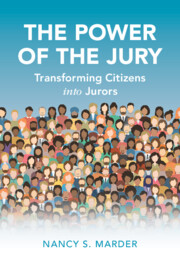Book contents
- The Power of the Jury
- Cambridge Studies in Law and Society
- The Power of the Jury
- Copyright page
- Contents
- Acknowledgments
- Introduction
- 1 The Summons and the Setting: Beginning the Transformation of Citizens into Jurors
- 2 Voir Dire: Introducing Jurors to the Judge, Their Fellow Jurors, and Their Role
- 3 Peremptory Challenges: A Barrier That Unnecessarily Limits Who Can Serve as Jurors
- 4 Jury Instructions: Reinforcing Group Identity and Making Instructions Accessible to Jurors
- 5 Jury Deliberations: Performing the Jury’s Main Task with Some Assistance from the Judge
- 6 The Post-Verdict Interview: How Judges Can Help Jurors in Their Transformation from Jurors into Engaged Citizens
- Conclusion
- Index
- Cambridge Studies in Law and Society
Introduction
Published online by Cambridge University Press: 25 August 2022
- The Power of the Jury
- Cambridge Studies in Law and Society
- The Power of the Jury
- Copyright page
- Contents
- Acknowledgments
- Introduction
- 1 The Summons and the Setting: Beginning the Transformation of Citizens into Jurors
- 2 Voir Dire: Introducing Jurors to the Judge, Their Fellow Jurors, and Their Role
- 3 Peremptory Challenges: A Barrier That Unnecessarily Limits Who Can Serve as Jurors
- 4 Jury Instructions: Reinforcing Group Identity and Making Instructions Accessible to Jurors
- 5 Jury Deliberations: Performing the Jury’s Main Task with Some Assistance from the Judge
- 6 The Post-Verdict Interview: How Judges Can Help Jurors in Their Transformation from Jurors into Engaged Citizens
- Conclusion
- Index
- Cambridge Studies in Law and Society
Summary
How does a group of strangers, many of whom are initially unhappy about serving as jurors, become a jury that works together as a group to reach a unanimous verdict based on the evidence that was presented to them during the trial and who leave their experience satisfied with the job they have done and with the jury system? The answer lies in the jury process and the way in which it transforms citizens into jurors. The various stages of the jury process, including the summons, voir dire, instructions, and deliberations, help citizens to step into their role as jurors. The final stage, the post-verdict interview with the judge, helps jurors to leave their role as jurors behind and to resume their lives as private citizens who will serve as emissaries for the jury. Although the jury process carries out this transformation of citizens into jurors reasonably well, there is still room for improvement. Each of the stages of the jury process can be improved upon by looking at the process as a whole rather than each stage in isolation, and by ensuring that any reforms further the transformation of citizens into jurors.
- Type
- Chapter
- Information
- The Power of the JuryTransforming Citizens into Jurors, pp. 1 - 12Publisher: Cambridge University PressPrint publication year: 2022

